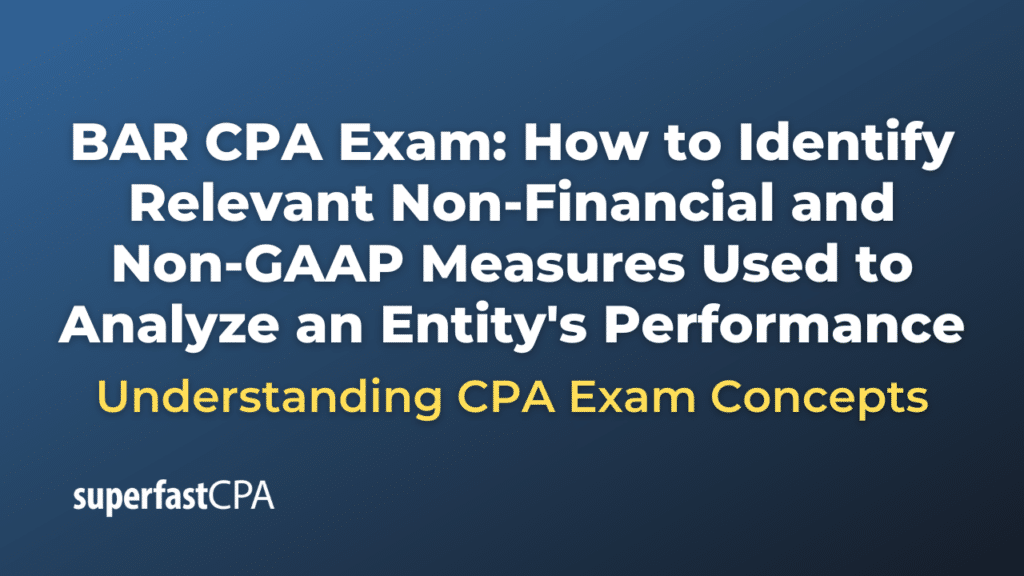Introduction
Purpose of the Article
In this article, we’ll cover how to identify relevant non-financial and non-GAAP measures used to analyze an entity’s performance. In today’s complex business environment, relying solely on traditional financial metrics is often insufficient to capture the full picture of an entity’s performance. Non-financial and non-GAAP measures have emerged as essential tools for investors, analysts, and management, providing deeper insights into a company’s operational health, strategic direction, and long-term viability. These measures offer a more nuanced view of performance, highlighting areas that traditional financial statements may not fully reflect.
For professionals preparing for the BAR CPA exam, understanding non-financial and non-GAAP measures is crucial. These measures enable a comprehensive approach to performance analysis, helping stakeholders evaluate an entity’s strengths, weaknesses, and future potential. By incorporating these metrics, professionals can make more informed decisions, communicate more effectively with investors, and ensure compliance with regulatory standards.
Overview of Non-GAAP and Non-Financial Measures
Non-GAAP Measures refer to financial metrics that are adjusted from the Generally Accepted Accounting Principles (GAAP) to provide a clearer picture of an entity’s core operations. Companies often use non-GAAP measures to exclude items that are unusual, non-recurring, or not reflective of their core operating performance. For example, adjustments might be made for restructuring costs, litigation settlements, or other one-time expenses. The goal is to present a more accurate depiction of the company’s operational performance, which GAAP metrics might obscure due to the inclusion of these atypical items.
Non-Financial Measures, on the other hand, are metrics that assess aspects of an entity’s performance that are not directly tied to financial outcomes. These measures often include indicators such as customer satisfaction, employee engagement, market share, and environmental impact. Non-financial measures provide insight into the qualitative aspects of a company’s operations, helping stakeholders understand the broader impact of business activities beyond just financial returns. As companies and investors focus more on long-term sustainability, corporate governance, and social responsibility, these metrics are increasingly important.
Together, non-GAAP and non-financial measures form a comprehensive toolkit for analyzing an entity’s performance. They offer a broader perspective that encompasses both the quantitative and qualitative dimensions of a company’s operations, ensuring that decisions are based on a well-rounded understanding of the business.
Understanding Non-GAAP Measures
Definition of Non-GAAP Measures
Non-GAAP measures are financial metrics that companies use to present their performance in a way that deviates from the standards set by Generally Accepted Accounting Principles (GAAP). These measures allow companies to exclude certain items that they believe do not accurately reflect their ongoing business operations. By doing so, non-GAAP measures aim to provide a clearer picture of the company’s core operating performance.
The key difference between GAAP and non-GAAP measures lies in their adherence to standardized accounting principles. GAAP measures are governed by strict accounting rules designed to ensure consistency and comparability across companies. Non-GAAP measures, however, are not bound by these rules and are tailored by companies to highlight specific aspects of their performance. While this flexibility can provide valuable insights, it also introduces the potential for inconsistency and lack of comparability if not used transparently.
Common Examples of Non-GAAP Measures
Adjusted EBITDA
Adjusted EBITDA (Earnings Before Interest, Taxes, Depreciation, and Amortization) is a widely used non-GAAP measure that reflects a company’s profitability by excluding non-operating expenses and non-cash charges. Adjusted EBITDA typically excludes items such as restructuring costs, litigation settlements, and stock-based compensation. This measure is often used to assess a company’s operational efficiency and compare its performance to peers without the distortion of these non-recurring or non-cash items.
Free Cash Flow
Free Cash Flow (FCF) is another common non-GAAP measure that represents the cash a company generates after accounting for capital expenditures needed to maintain or expand its asset base. It provides insight into a company’s ability to generate cash that can be used for dividends, debt repayment, or reinvestment in the business. FCF is calculated by subtracting capital expenditures from operating cash flow, giving a more accurate view of the cash available to the company beyond its immediate operational needs.
Core Earnings
Core Earnings refer to a non-GAAP measure that focuses on the profitability derived from a company’s primary business activities, excluding any non-recurring or unusual items. This measure helps investors and analysts assess the sustainability of a company’s earnings by filtering out the noise from one-time events, such as asset sales or legal settlements. Core Earnings aim to provide a clearer understanding of how well a company’s core operations are performing.
Pro Forma Earnings
Pro Forma Earnings are a non-GAAP measure that companies use to adjust reported earnings to reflect the impact of certain events as if they had occurred at an earlier time. This might include the effect of mergers, acquisitions, or other significant changes. Pro forma earnings help investors understand how these events would have affected the company’s financial results had they been in place for the entire reporting period. This measure is often used to provide a forward-looking perspective on a company’s financial health.
Why Entities Use Non-GAAP Measures
Entities use non-GAAP measures for several key reasons, each of which can provide unique insights into a company’s performance:
- Flexibility: Non-GAAP measures offer companies the flexibility to tailor financial metrics to better reflect their specific operational realities. By excluding items that are not indicative of ongoing operations, companies can present a clearer picture of their core business performance.
- Investor Communication: Non-GAAP measures can enhance communication with investors by providing additional context to the financial results. They allow companies to tell a more complete story, especially when GAAP metrics may not fully capture the nuances of their operations. For example, by reporting adjusted EBITDA, a company can highlight its operational efficiency without the distortion of non-recurring expenses.
- Performance Tracking: Companies often use non-GAAP measures to track performance internally. These measures can provide management with a more accurate view of how the business is performing relative to its strategic goals. By focusing on metrics that align more closely with the company’s core operations, management can make better-informed decisions regarding resource allocation, strategic initiatives, and performance improvement.
While non-GAAP measures provide valuable insights, it is important for companies to use them transparently and consistently. This ensures that investors and other stakeholders can rely on these measures as part of their overall analysis, without being misled by adjustments that might obscure the true financial performance of the entity.
Understanding Non-Financial Measures
Definition of Non-Financial Measures
Non-financial measures are metrics that assess aspects of an entity’s performance that are not directly tied to financial outcomes but are nonetheless crucial to understanding the overall health and success of the business. These measures focus on qualitative factors such as customer satisfaction, employee engagement, market position, and corporate social responsibility. While they do not appear in financial statements, non-financial measures have a significant impact on a company’s long-term financial performance.
The relationship between non-financial and financial performance is increasingly recognized as critical. Non-financial measures often serve as leading indicators of future financial outcomes. For example, high customer satisfaction can lead to increased sales and revenue, while strong employee engagement can drive productivity and reduce costs associated with turnover. By analyzing non-financial measures, companies can gain insights into areas that directly or indirectly affect their financial performance, enabling more proactive and informed decision-making.
Common Examples of Non-Financial Measures
Customer Satisfaction Scores (NPS)
Customer Satisfaction Scores, often measured by the Net Promoter Score (NPS), gauge how satisfied customers are with a company’s products or services. NPS is calculated by asking customers how likely they are to recommend the company to others on a scale from 0 to 10. The score is then derived by subtracting the percentage of detractors (those who score 6 or below) from the percentage of promoters (those who score 9 or 10). A high NPS indicates strong customer loyalty, which can lead to increased revenue and market share.
Employee Turnover Rate
Employee Turnover Rate measures the rate at which employees leave a company within a specific period. High turnover can indicate problems within the organization, such as poor management, lack of employee engagement, or inadequate compensation. Conversely, a low turnover rate suggests a stable and satisfied workforce, which can enhance productivity and reduce costs associated with recruiting and training new employees. This measure is critical for understanding the internal health of an organization and its ability to retain talent.
Market Share
Market Share represents the percentage of an industry’s sales that a particular company controls. It is a key indicator of a company’s competitive position within its industry. A growing market share suggests that the company is performing well relative to its competitors, which can lead to increased revenue and profitability. Conversely, a declining market share may signal competitive challenges or shifts in consumer preferences. Understanding market share helps companies assess their strategic position and the effectiveness of their marketing and sales efforts.
Brand Strength and Reputation
Brand Strength and Reputation are measures of how well a company is perceived by consumers, investors, and other stakeholders. A strong brand can lead to customer loyalty, premium pricing, and competitive advantage. Brand reputation is often assessed through surveys, social media sentiment analysis, and brand equity studies. A positive reputation can enhance customer retention and attract new customers, while a damaged reputation can have significant financial and operational repercussions.
Environmental, Social, and Governance (ESG) Metrics
Environmental, Social, and Governance (ESG) Metrics assess a company’s performance in areas related to sustainability, social responsibility, and ethical governance. These measures have gained prominence as investors and consumers increasingly prioritize corporate responsibility. ESG metrics might include carbon footprint, diversity and inclusion initiatives, and corporate governance practices. Companies with strong ESG performance are often viewed more favorably by investors, which can enhance their access to capital and improve their market valuation.
Why Entities Use Non-Financial Measures
Entities use non-financial measures because they provide a more holistic view of performance, capturing elements that traditional financial metrics might overlook. These measures help companies to:
- Understand Drivers of Financial Performance: Non-financial measures often serve as early indicators of financial success. For example, high customer satisfaction can lead to increased sales, and a strong brand reputation can support higher pricing power. By monitoring these measures, companies can identify trends that may impact financial performance before they are reflected in financial statements.
- Enhance Decision-Making: Non-financial measures provide insights into areas that are critical for long-term success but may not be immediately apparent in financial data. For instance, understanding employee engagement can help management address potential issues before they affect productivity or lead to high turnover. These insights enable more informed decision-making and strategic planning.
- Communicate Value Beyond Financials: In today’s business environment, stakeholders, including investors, customers, and employees, increasingly value non-financial performance. By reporting on non-financial measures, companies can demonstrate their commitment to sustainability, social responsibility, and ethical practices, which can enhance their reputation and attract socially conscious investors and customers.
- Align with Strategic Objectives: Non-financial measures are often closely aligned with a company’s strategic goals. For example, if a company’s strategy emphasizes customer satisfaction, monitoring NPS scores becomes essential. These measures ensure that the company’s operations are consistent with its long-term vision and objectives.
Non-financial measures play a critical role in providing a comprehensive view of an entity’s performance. They complement financial metrics by offering insights into the qualitative aspects of the business that drive long-term success and sustainability.
Identifying Relevant Non-GAAP Measures
Industry-Specific Non-GAAP Measures
Non-GAAP measures are often tailored to reflect the unique characteristics of different industries, providing insights that standardized GAAP metrics may not fully capture. These industry-specific measures allow companies to present a more accurate picture of their operational performance and are crucial for stakeholders who want to understand the nuances of a particular sector.
For example, in the retail industry, one of the most common non-GAAP measures is Same-Store Sales (SSS). SSS measures the revenue growth of stores that have been open for a year or more, excluding the impact of new store openings or closures. This metric helps investors and analysts assess the organic growth of a retailer, distinguishing it from growth driven by expansion.
In the technology sector, companies often use Monthly Recurring Revenue (MRR) or Annual Recurring Revenue (ARR) as non-GAAP measures. These metrics focus on the predictable, recurring portion of revenue, excluding one-time sales or non-recurring revenues. MRR and ARR are particularly relevant for subscription-based businesses, such as software-as-a-service (SaaS) companies, where consistent revenue streams are key indicators of long-term stability.
In the oil and gas industry, EBITDAX (Earnings Before Interest, Taxes, Depreciation, Amortization, and Exploration Expenses) is a commonly used non-GAAP measure. This metric excludes exploration costs, which can be highly variable and are often not indicative of the core operational performance. EBITDAX allows for a clearer comparison of companies in this sector by focusing on their operational efficiency without the distortion of exploration expenses.
Assessing the Quality and Relevance of Non-GAAP Measures
When evaluating the quality and relevance of non-GAAP measures, several factors should be considered:
- Consistency: One of the primary criteria for assessing a non-GAAP measure is consistency over time. Companies should use the same adjustments consistently from period to period. This allows stakeholders to compare results across different reporting periods and assess trends accurately.
- Transparency: Companies must clearly explain the adjustments they make to GAAP measures to arrive at their non-GAAP metrics. This includes a detailed reconciliation between the GAAP and non-GAAP figures, along with an explanation of why these adjustments provide a better understanding of the company’s performance.
- Alignment with Business Strategy: The relevance of a non-GAAP measure is often tied to how well it aligns with the company’s strategic objectives. For instance, a measure like MRR is highly relevant for a SaaS company focused on growing its subscription base. If a non-GAAP measure provides meaningful insight into the company’s core business strategy, it is likely to be more useful for stakeholders.
- Comparability: Non-GAAP measures should allow for comparability with peer companies. If a company uses unique adjustments that make its metrics difficult to compare with those of competitors, the usefulness of the measure may be diminished. Stakeholders should be cautious of non-GAAP measures that deviate significantly from industry norms without clear justification.
- Materiality: The adjustments made to create non-GAAP measures should be material enough to affect the understanding of the company’s performance. If the adjustments are minor or do not significantly alter the financial picture, the non-GAAP measure may not add much value.
Regulatory Considerations and Transparency
The use of non-GAAP measures is closely monitored by regulatory bodies such as the Securities and Exchange Commission (SEC) in the United States. The SEC has established guidelines to ensure that these measures are used appropriately and transparently, preventing companies from misleading investors.
- SEC Guidelines: The SEC requires that any non-GAAP measure presented in a company’s financial disclosures be accompanied by the most directly comparable GAAP measure, along with a reconciliation of the two. This helps ensure that investors can see how the non-GAAP figures relate to the standard GAAP results.
- Prohibition of Misleading Adjustments: The SEC prohibits companies from using non-GAAP measures that could be misleading. For example, a company cannot present a non-GAAP measure that suggests it is more profitable than it actually is under GAAP, without clear and transparent justification for the adjustments.
- Prominence: The SEC also mandates that non-GAAP measures should not be presented with undue prominence over GAAP measures. This means that companies should not highlight non-GAAP metrics in a way that overshadows the standard GAAP results, ensuring that investors maintain a balanced view of the company’s performance.
- Importance of Consistency: Consistency is a key principle emphasized by the SEC. Companies are encouraged to use the same non-GAAP measures across reporting periods and to be consistent in the adjustments they make. This allows for more meaningful comparisons over time and reduces the risk of manipulating figures to present an overly favorable view.
- Transparency and Disclosure: Full transparency is critical when presenting non-GAAP measures. Companies must clearly disclose the rationale for using these measures and explain how they provide additional insight into the company’s performance. This includes a detailed explanation of each adjustment made and how it aligns with the company’s financial strategy and operational objectives.
While non-GAAP measures can offer valuable insights into an entity’s performance, their use must be carefully evaluated for quality, relevance, and transparency. Regulatory guidelines play an essential role in ensuring that these measures are used appropriately, helping to maintain trust and integrity in financial reporting.
Identifying Relevant Non-Financial Measures
Industry-Specific Non-Financial Measures
Non-financial measures vary widely across industries, reflecting the unique characteristics and key performance drivers of each sector. These measures provide critical insights into areas that are not directly captured by financial metrics but are essential for understanding an entity’s overall health and operational effectiveness.
For example, in the telecommunications industry, the churn rate is a vital non-financial measure. Churn rate refers to the percentage of customers who discontinue their service within a given time period. High churn rates can indicate dissatisfaction with service quality, pricing, or customer support. Monitoring and managing churn rate is crucial for telecom companies because retaining customers is often more cost-effective than acquiring new ones.
In the hospitality industry, occupancy rate is a key non-financial measure. This metric tracks the percentage of available rooms that are occupied over a specific period. Occupancy rate is directly linked to revenue generation but also reflects customer demand, brand strength, and market competitiveness. It helps hotels and resorts gauge their operational efficiency and effectiveness in attracting and retaining guests.
In the healthcare sector, patient satisfaction scores are critical non-financial measures. These scores assess patients’ experiences and perceptions of care quality, which can significantly impact a healthcare provider’s reputation and financial performance. High patient satisfaction is often associated with better patient outcomes, increased patient retention, and reduced risk of malpractice claims.
In the manufacturing industry, production downtime is an important non-financial measure. It tracks the amount of time that production is halted due to equipment failures, maintenance, or other issues. Minimizing downtime is essential for maintaining operational efficiency and meeting production targets, directly affecting a company’s ability to fulfill orders and maintain profitability.
Aligning Non-Financial Measures with Strategic Objectives
For non-financial measures to be truly effective, they must be closely aligned with an entity’s strategic objectives. This alignment ensures that the measures provide meaningful insights into the progress towards achieving key goals and enable management to make informed decisions that support long-term success.
When selecting non-financial measures, it is important to consider the entity’s overarching strategy. For instance, if a company’s strategic goal is to enhance customer loyalty, it might prioritize non-financial measures such as customer satisfaction scores or net promoter scores (NPS). These metrics directly relate to the company’s objective of improving customer relationships and can help track the effectiveness of initiatives aimed at boosting loyalty.
Similarly, a company focused on innovation might emphasize non-financial measures such as R&D spending or the number of new product launches. These measures align with the strategic objective of driving growth through innovation and help assess whether the company is investing adequately in new technologies and product development.
In the context of sustainability, companies may align their non-financial measures with their environmental, social, and governance (ESG) goals. For example, a company committed to reducing its carbon footprint might track metrics such as greenhouse gas emissions or energy consumption. These measures not only support the company’s sustainability objectives but also enhance its reputation among environmentally conscious consumers and investors.
Challenges in Measuring Non-Financial Metrics
While non-financial measures provide valuable insights, they also present several challenges in terms of capturing, quantifying, and consistently reporting these metrics.
- Data Collection: One of the primary challenges is gathering accurate and reliable data. Unlike financial metrics, which are derived from standardized accounting systems, non-financial measures often require data from various sources, such as customer surveys, employee feedback, or operational records. Ensuring the accuracy and completeness of this data can be difficult, especially in large or complex organizations.
- Quantification: Another challenge is quantifying non-financial measures in a way that is meaningful and comparable over time. For example, measuring customer satisfaction involves subjective assessments that may vary depending on the methodology used or the sample of respondents. Developing consistent and objective criteria for quantifying these measures is essential for reliable analysis.
- Consistency in Reporting: Non-financial measures can be challenging to report consistently across different periods or business units. Changes in data collection methods, operational practices, or strategic priorities can lead to variations in how these measures are reported. Ensuring consistency requires clear guidelines and standardized procedures for measuring and reporting non-financial metrics.
- Interpretation and Relevance: Interpreting non-financial measures can be complex, as their relevance may vary depending on the context. For instance, a high employee turnover rate might be concerning in one industry but less so in another where short-term contracts are common. Understanding the specific context and industry norms is crucial for accurately interpreting non-financial measures.
- Integration with Financial Performance: Finally, integrating non-financial measures with financial performance analysis can be challenging. While non-financial measures often provide leading indicators of future financial outcomes, establishing a direct link between the two requires careful analysis and may involve making assumptions about how non-financial factors will influence financial results.
Despite these challenges, effectively measuring and reporting non-financial metrics is crucial for providing a comprehensive view of an entity’s performance. By addressing these challenges and ensuring that non-financial measures are aligned with strategic objectives, companies can enhance their ability to manage and communicate their performance in a holistic and meaningful way.
Integrating Non-GAAP and Non-Financial Measures in Performance Analysis
Complementary Role of Non-GAAP and Non-Financial Measures
Non-GAAP and non-financial measures, when used together, provide a more comprehensive view of an entity’s performance by capturing both the quantitative and qualitative aspects of its operations. While GAAP measures offer a standardized, financial-based view of a company’s results, non-GAAP measures allow for adjustments that reflect the core operational performance. Non-financial measures, on the other hand, shed light on factors that influence long-term success, such as customer satisfaction, employee engagement, and brand reputation.
The complementary nature of these measures lies in their ability to fill in the gaps left by traditional financial metrics. For example, a company might report strong non-GAAP earnings by excluding one-time restructuring costs, indicating healthy operational performance. Simultaneously, high customer satisfaction scores (a non-financial measure) suggest that the company’s products or services are well-received, supporting the sustainability of these earnings. Together, these measures provide a fuller picture of the company’s current and future prospects, offering insights that neither could deliver on its own.
Moreover, integrating non-GAAP and non-financial measures helps stakeholders understand the drivers behind financial results. For instance, if a company’s non-GAAP free cash flow is robust, examining related non-financial measures like employee productivity or supply chain efficiency can reveal the operational factors contributing to this cash flow. This integrated approach allows for more informed decision-making, as it considers both the financial outcomes and the underlying non-financial factors that influence them.
Case Studies and Examples
Example 1: Retail Industry – Non-GAAP Measure (Same-Store Sales) and Non-Financial Measure (Customer Satisfaction)
A large retail chain reports a non-GAAP measure of Same-Store Sales (SSS) growth of 5% for the quarter. To understand the sustainability of this growth, the company also tracks Customer Satisfaction Scores (NPS), a key non-financial measure. The NPS for the same period indicates an increase in customer satisfaction, driven by recent improvements in store layout and customer service. By integrating these measures, the company can demonstrate that the SSS growth is not just due to temporary promotions but is also supported by enhanced customer experience, suggesting that the growth is sustainable.
Example 2: Technology Sector – Non-GAAP Measure (Adjusted EBITDA) and Non-Financial Measure (Employee Turnover Rate)
A software company reports an increase in Adjusted EBITDA, a non-GAAP measure that excludes stock-based compensation and one-time restructuring costs. To provide a more comprehensive analysis, the company also monitors its Employee Turnover Rate, a non-financial measure. Despite the strong financial performance, a rising turnover rate suggests potential issues with employee satisfaction or company culture, which could negatively impact future performance. This integrated analysis prompts management to investigate and address the root causes of the turnover, ensuring long-term operational stability.
Example 3: Healthcare Industry – Non-GAAP Measure (Free Cash Flow) and Non-Financial Measure (Patient Satisfaction)
A healthcare provider reports strong Free Cash Flow (FCF) for the fiscal year, indicating efficient cash management and operational performance. However, the company also tracks Patient Satisfaction Scores, a critical non-financial measure. A decline in patient satisfaction scores raises concerns about the quality of care, which could lead to lower patient retention and potential regulatory scrutiny. By integrating these measures, the company recognizes the need to invest in improving patient care to sustain its financial performance and avoid future risks.
Key Takeaways for Practitioners
- Identify Relevant Measures: Start by identifying the non-GAAP and non-financial measures most relevant to your industry and strategic goals. Ensure that these measures provide insights that align with your company’s key performance drivers and long-term objectives.
- Ensure Consistency and Transparency: Use non-GAAP measures consistently across reporting periods, and provide clear explanations for any adjustments made. Similarly, ensure that non-financial measures are quantified and reported consistently to maintain credibility and comparability over time.
- Integrate Measures for Comprehensive Analysis: Combine non-GAAP and non-financial measures to gain a more holistic view of performance. Use non-GAAP measures to adjust for non-recurring items and highlight core operations, while non-financial measures provide insights into the qualitative aspects that influence long-term success.
- Align with Strategic Objectives: Ensure that both non-GAAP and non-financial measures are aligned with your entity’s strategic objectives. This alignment helps to track progress towards achieving key goals and supports decision-making that drives long-term value creation.
- Monitor and Respond to Non-Financial Indicators: Pay close attention to non-financial measures that serve as leading indicators of future financial performance. Be proactive in addressing any negative trends in these measures to prevent potential impacts on financial outcomes.
By following these practical steps, practitioners can effectively integrate non-GAAP and non-financial measures into their performance analysis, providing a more comprehensive and actionable understanding of an entity’s true operational health and future potential.
Conclusion
Recap of Key Points
Understanding and identifying relevant non-GAAP and non-financial measures is essential for gaining a comprehensive view of an entity’s performance. Non-GAAP measures provide a more accurate depiction of a company’s operational health by adjusting for items that may obscure true performance, while non-financial measures offer insights into qualitative factors that drive long-term success, such as customer satisfaction, employee engagement, and brand reputation. Together, these measures complement traditional financial metrics, enabling a more nuanced and complete analysis of a company’s current state and future prospects.
By carefully selecting industry-specific non-GAAP and non-financial measures, aligning them with strategic objectives, and ensuring consistency and transparency in their reporting, companies can provide stakeholders with a clearer and more holistic view of their performance. This integrated approach not only enhances decision-making but also strengthens the company’s ability to communicate its value to investors, customers, and other key stakeholders.
Final Thoughts
In an increasingly complex and competitive business environment, relying solely on traditional financial metrics is no longer sufficient. Non-GAAP and non-financial measures play a critical role in providing a more comprehensive performance analysis, capturing the full spectrum of factors that influence a company’s success. These measures help bridge the gap between financial results and the underlying drivers of long-term value, offering a deeper understanding of an entity’s true potential.
For professionals preparing for the BAR CPA exam and those working in financial analysis, mastering the identification and interpretation of non-GAAP and non-financial measures is crucial. These skills enable a more complete and accurate assessment of an entity’s performance, helping to ensure that decisions are based on a well-rounded understanding of both the quantitative and qualitative aspects of the business. As the business landscape continues to evolve, the ability to integrate and analyze these measures will remain a key differentiator in effective performance management and strategic planning.














